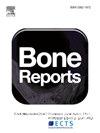Combination or sequential teriparatide for osteoporosis treatment in denosumab-users: real-world bone mineral density outcomes
IF 2.6
Q3 ENDOCRINOLOGY & METABOLISM
引用次数: 0
Abstract
The optimal osteoanabolic strategy in denosumab (Dmab)-users remains uncertain. In treatment-naïve patients, Dmab/teriparatide (TPTD) combinations result in dramatic bone mineral density (BMD) gains at the spine and hip. However, BMD outcomes with combination Dmab/TPTD have not been investigated in patients on established Dmab.
We retrospectively reviewed patients with osteoporosis at two Sydney centers between 2013 and 2023. Eligible patients were managed with Dmab immediately before ≥12-months TPTD. Patients were grouped according to whether TPTD was added to ongoing Dmab (combination) or Dmab was withheld during TPTD (sequence). BMD outcomes were assessed during TPTD.
The total cohort (N = 23; 11 = combination, 12 = sequence) had mean age 77 ± 7 years and were predominantly female (87 %). Overall, prior vertebral (52 %) and non-vertebral fractures (2.4 ± 1.5) were prevalent and pre-TPTD BMD T-scores (SD) low at lumbar spine (−2.4 ± 1.2) and total hip (−2.2 ± 0.6). Median Dmab exposure was 5-doses (IQR 3–11), median overall antiresorptive exposure was 6-years (IQR 4–11) and majority (>90 %) received 18-months TPTD. Groups were similar in age, sex, Dmab and overall antiresorptive exposure, fracture prevalence, DXA interval and pre-TPTD BMD values. Combination Dmab/TPTD was associated with significant lumbar spine BMD gains (+0.080 g/cm2 ± 0.059 g/cm2, p = 0.004; +9.8 %). No significant BMD change occurred during sequential Dmab/TPTD (+0.026 g/cm2 ± 0.049 g/cm2, p = 0.107; +3.5 %). Combination Dmab/TPTD resulted in greater lumbar spine BMD gains (p = 0.039). Hip and femoral neck BMD remained stable in both groups.
In this retrospective study, significant lumbar spine BMD gains occurred during combined Dmab/TPTD in patients on established Dmab. These results warrant prospective controlled studies to further inform optimal osteoanabolic strategies in Dmab-users.
联合或序贯特立帕肽治疗denosumumab使用者骨质疏松症:真实世界骨密度结果
denosumab (Dmab)使用者的最佳骨合成代谢策略仍不确定。在treatment-naïve患者中,Dmab/teriparatide (TPTD)联合治疗可显著提高脊柱和髋部骨矿物质密度(BMD)。然而,在已建立Dmab的患者中,尚未研究Dmab/TPTD联合治疗的BMD结果。我们回顾性分析了2013年至2023年间悉尼两个中心的骨质疏松症患者。符合条件的患者在TPTD≥12个月前立即接受Dmab治疗。根据是否将TPTD添加到正在进行的Dmab(联合)或在TPTD(序列)期间保留Dmab对患者进行分组。在TPTD期间评估BMD结果。总队列(N = 23;11例为合并,12例为顺序),平均年龄77±7岁,以女性为主(87%)。总体而言,既往椎体骨折(52%)和非椎体骨折(2.4±1.5)普遍存在,tptd前BMD t评分(SD)在腰椎(- 2.4±1.2)和全髋关节(- 2.2±0.6)较低。中位Dmab暴露为5剂(IQR 3-11),中位总体抗吸收暴露为6年(IQR 4-11),大多数(> 90%)接受了18个月的TPTD。各组在年龄,性别,Dmab和总体抗吸收暴露,骨折发生率,DXA间隔和ttptd前BMD值方面相似。Dmab/TPTD联合用药可显著增加腰椎骨密度(+0.080 g/cm2±0.059 g/cm2, p = 0.004;+ 9.8%)。连续Dmab/TPTD组骨密度无显著变化(+0.026 g/cm2±0.049 g/cm2, p = 0.107;+ 3.5%)。Dmab/TPTD联合治疗导致腰椎骨密度增加(p = 0.039)。两组患者的髋关节和股骨颈骨密度均保持稳定。在这项回顾性研究中,在已建立Dmab的患者中,在Dmab/TPTD联合治疗期间,腰椎骨密度显著增加。这些结果支持前瞻性对照研究,以进一步为dmab使用者提供最佳的骨合成代谢策略。
本文章由计算机程序翻译,如有差异,请以英文原文为准。
求助全文
约1分钟内获得全文
求助全文
来源期刊

Bone Reports
Medicine-Orthopedics and Sports Medicine
CiteScore
4.30
自引率
4.00%
发文量
444
审稿时长
57 days
期刊介绍:
Bone Reports is an interdisciplinary forum for the rapid publication of Original Research Articles and Case Reports across basic, translational and clinical aspects of bone and mineral metabolism. The journal publishes papers that are scientifically sound, with the peer review process focused principally on verifying sound methodologies, and correct data analysis and interpretation. We welcome studies either replicating or failing to replicate a previous study, and null findings. We fulfil a critical and current need to enhance research by publishing reproducibility studies and null findings.
 求助内容:
求助内容: 应助结果提醒方式:
应助结果提醒方式:


